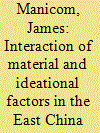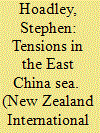| Srl | Item |
| 1 |
ID:
131261


|
|
|
|
|
| Publication |
2014.
|
| Summary/Abstract |
Developments in the East China Sea disputes in recent years appear to have set back Northeast Asian regional integration. Are there ways of turning these negative developments into more positive ones? Taking the Ecuador-Peru territorial dispute as a model, I consider the possibility of conflict transformation for the East China Sea dispute. The Ecuador-Peru border dispute was the most protracted in the Western Hemisphere, yet a peace agreement was finally reached in 1998, suggesting that even the most deeply ingrained differences and most persistent disputes can be transformed and ultimately overcome.
|
|
|
|
|
|
|
|
|
|
|
|
|
|
|
|
| 2 |
ID:
085721


|
|
|
|
|
| Publication |
2008.
|
| Summary/Abstract |
This article seeks to explain the current phase of the East China Sea dispute between China and Japan. It argues that previous analyses privilege one aspect of the dispute over the other. Some stress the nationalist dimension of the dispute while others argue the primary motivations relate to the material wealth of the seabed combined with increased energy needs in China and Japan. By analysing the interaction between the nationalist (ideational) and resource (material) dimensions, it becomes clear why it has become increasingly difficult for policy elites in either state to seek compromise. This is because nationalist constituencies in China and Japan have extended their nationalist/ideational sentiment from the Senkaku/Diaoyu Islands to the entire East China Sea. Simultaneously, Beijing and Tokyo's interest in the material exploitation and security of the East China Sea has risen.
|
|
|
|
|
|
|
|
|
|
|
|
|
|
|
|
| 3 |
ID:
149646


|
|
|
|
|
| Summary/Abstract |
In the Libya/Malta case, the ICJ held that where the area to be delimited between two opposite States measures less than 400 nautical miles, distance, not natural prolongation determines title to the continental shelf. This was the Court’s interpretation of the definition of the continental shelf in Article 76(1) of the Law of the Sea Convention and of the relationship between the continental shelf and the exclusive economic zone. In the East China Sea which measures less than 400 nautical miles, China relies on natural prolongation while Japan relies on the distance principle. This paper analyses the Libya/Malta decision to ascertain its correctness or otherwise, and its usefulness for resolving the East China Sea dispute. The central argument in this paper is that the decision is inapplicable to the East China Sea dispute because it is incompatible with Articles 76(1), 77(3) and 56(3) of the Law of the Sea Convention.
|
|
|
|
|
|
|
|
|
|
|
|
|
|
|
|
| 4 |
ID:
129399


|
|
|